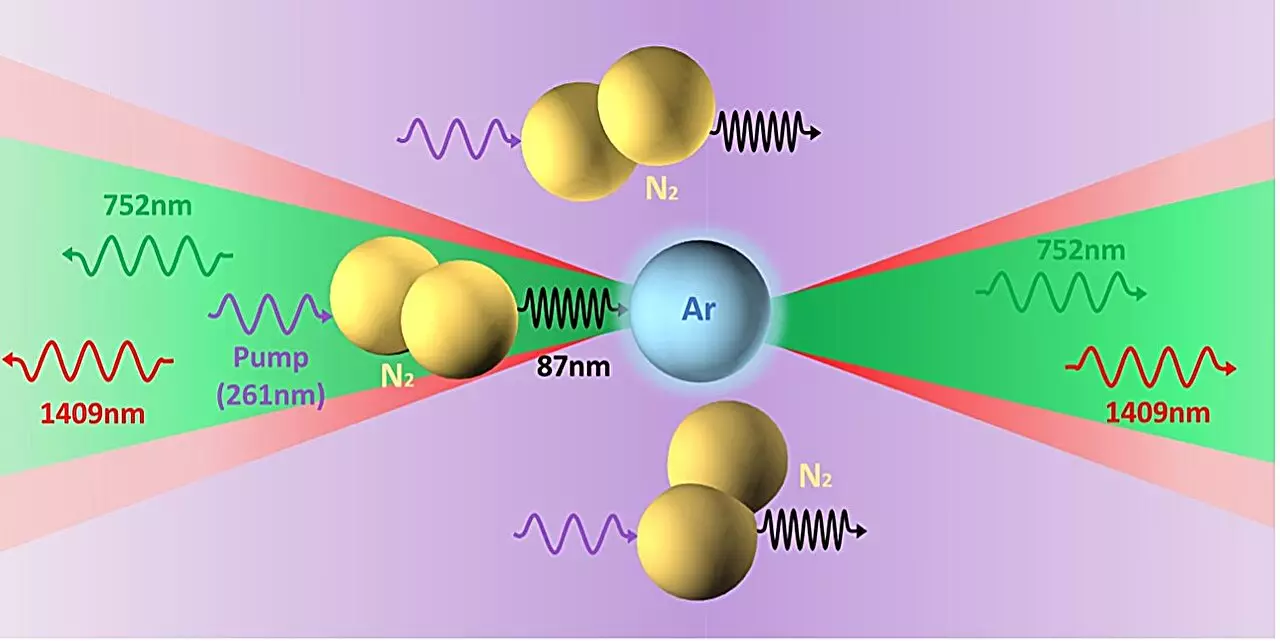Traditionally, the generation of laser light involves the use of optical cavities—pairs of precisely aligned mirrors that bounce light back and forth to amplify its intensity. This well-established mechanism has been a cornerstone in the field of photonics. However, groundbreaking research from teams at the University of California Los Angeles (UCLA) and the Max Born Institute has introduced a novel concept: the production of laser-like light in open air without these optical cavities. This phenomenon, termed cavity-free lasing, represents a transformative approach that could redefine how we understand and utilize laser technologies.
Recent findings published in the prestigious journal Physical Review Letters articulate a complex yet fascinating mechanism responsible for this phenomenon. The study focuses on energy transfer mediated by photons from nitrogen (N2) to argon (Ar) in the atmosphere. Co-author Chan Joshi noted a significant anomaly during their experiments; there was a conspicuous reduction in the ionization rate of argon when subjected to a 261 nm pump laser—an anomaly that deviated from predictions made by established theories like the PPT (Perturbation Theory) and the time-dependent Schrödinger equation.
Intrigued by this unexpected result, the researchers hypothesized that 3-photon resonant absorption of 261 nm photons in argon atoms was contributing to the reduced ionization rates, prompting them to delve deeper into their experimental observations.
Experimental Findings: Cascaded Superfluorescence
As the research progressed, the UCLA team discovered that the 3-photon absorption phenomenon was not just reducing ionization rates, but was also leading to the emission of cascaded superfluorescence—characterized by bidirectional and laser-like emission. Lead author Zan Nie pointed out that they observed a remarkable shift in wavelengths during cascaded superfluorescence when air was blended with 1% argon. This modification in emission characteristics hinted at a more intricate interplay between the various gases present in the atmosphere.
Upon further investigation, it became clear that this newly identified mechanism facilitated a unique form of lasing that could occur in both forward and backward directions, using atmospheric nitrogen as a conduit for energy transfer. This is a significant achievement, as traditional laser technologies are usually unidirectional.
The research emphasized how the constituents of the atmosphere—including nitrogen and argon—play critical roles in the generation of this laser-like effect. By selectively mixing argon with nitrogen, the researchers replicated the outcomes observed in ambient air, while mixtures containing other gases, such as oxygen or helium, did not yield similar results. Joshi explained that this vital coupling between nitrogen and argon is what truly enables the observed air lasing properties.
Importantly, the study also pointed out that nitrogen molecules, when placed in an electronically excited state, displayed nonlinear 3-photon absorption of the 261 nm wavelength. This nuance underpins the observed emergent behavior of the cascaded superfluorescence and highlights the importance of excited state dynamics in achieving efficient lasing in atmospheric conditions.
The research team’s revelations open up a realm of possibilities for the field of laser physics and remote sensing technologies. Co-author Misha Ivanov encapsulated the significance of their work by highlighting the potential to create a bidirectional laser effect in air—where a laser shot could elicit a laser-like burst of light in return. The applications for remote sensing, environmental monitoring, and perhaps even advanced communication systems could be transformative.
Looking ahead, the researchers plan to further investigate the detailed physics underlying this mechanism. Their future work may delve into phenomena such as quantum beating, which pertains to the simultaneous excitation of multiple energy levels within argon. These oscillations in charge density could afford deeper insights into both argon and nitrogen’s vibrational-rotational states—key components for optimizing radiative coupling.
Cavity-free lasing in atmospheric air is not merely an academic curiosity; it’s a pivotal leap that encapsulates the intersection of theoretical exploration and practical application. As researchers continue to decipher the complexities behind this ground-breaking mechanism, the potential benefits could ripple across various scientific domains. From enhancing remote sensing technologies to inspiring new methods for energy transfer in the atmosphere, the future undoubtedly looks bright for cavity-free lasers. The journey to harness this newly discovered phenomenon is just beginning, and its implications may very well revolutionize our interaction with light in the natural world.


Leave a Reply